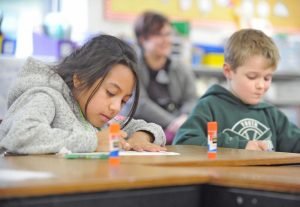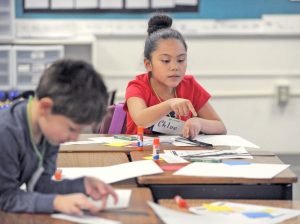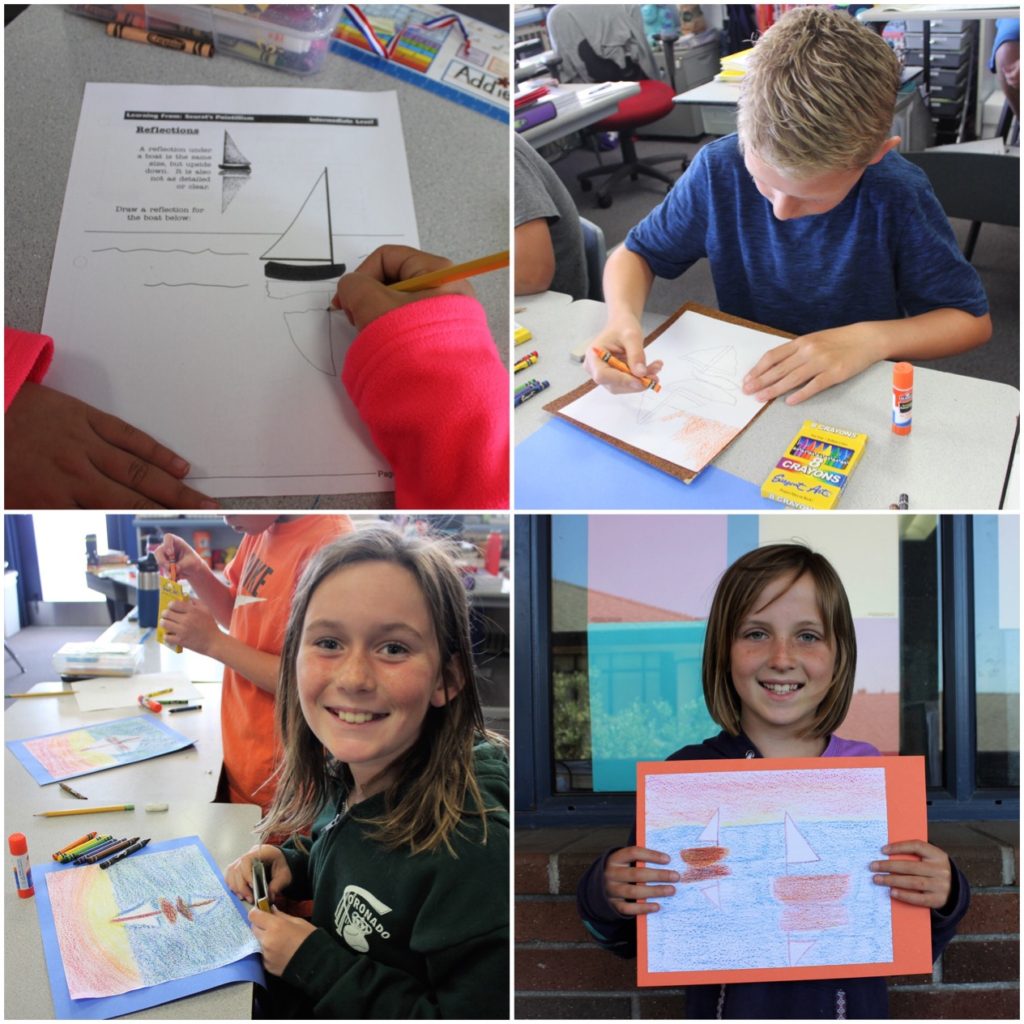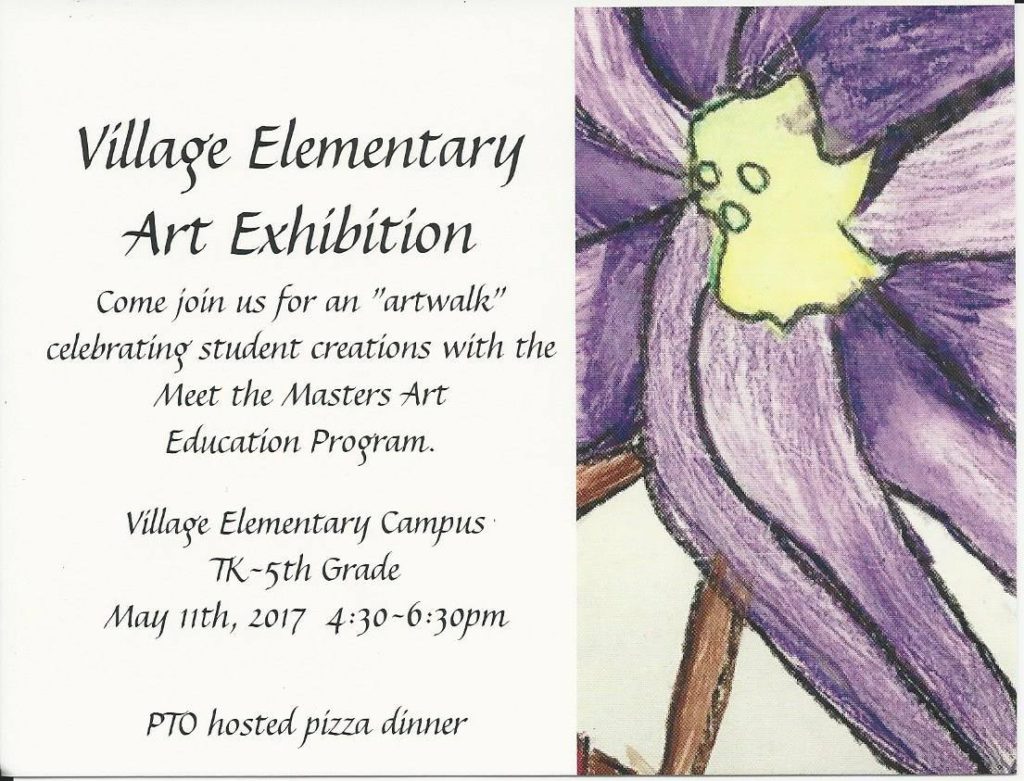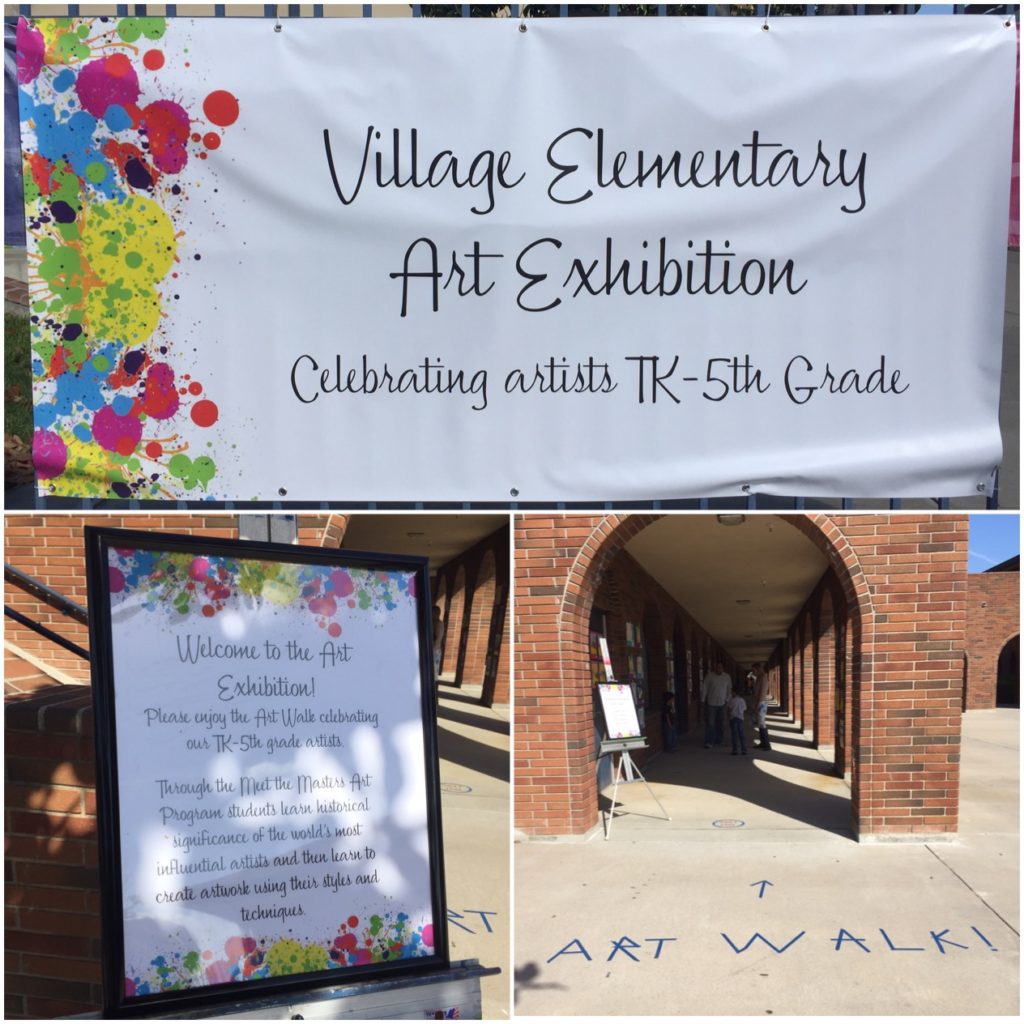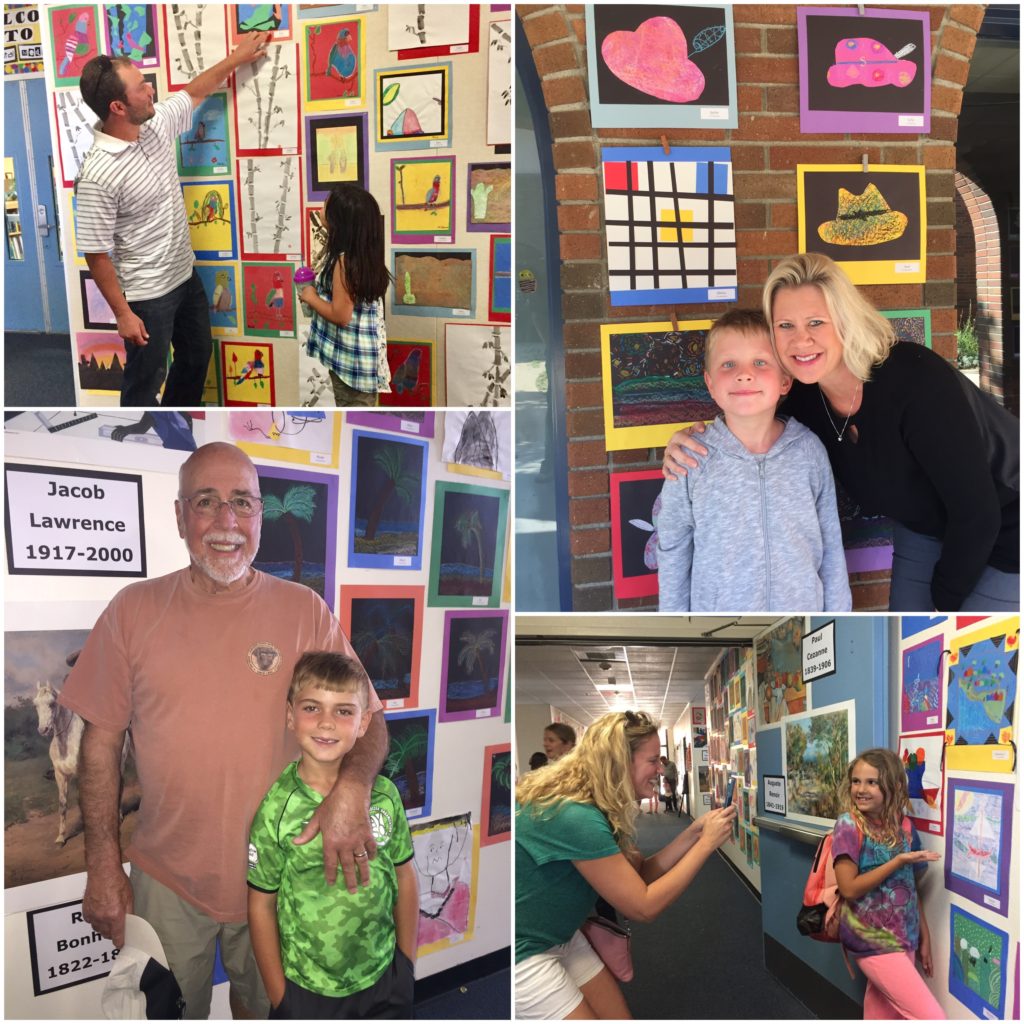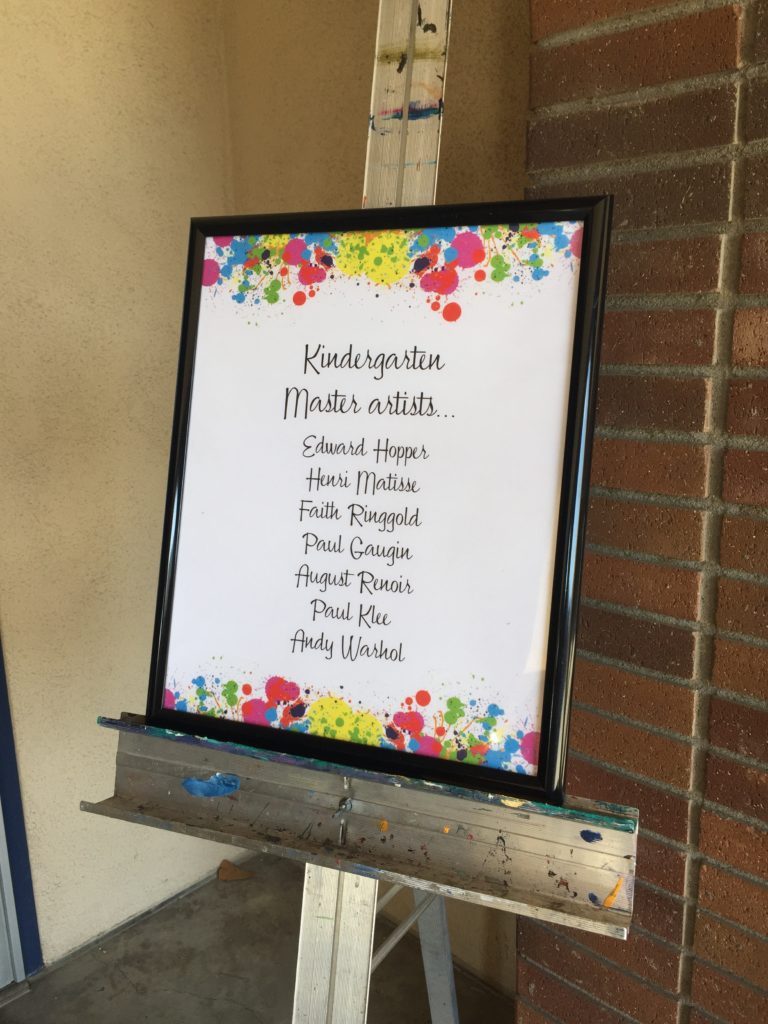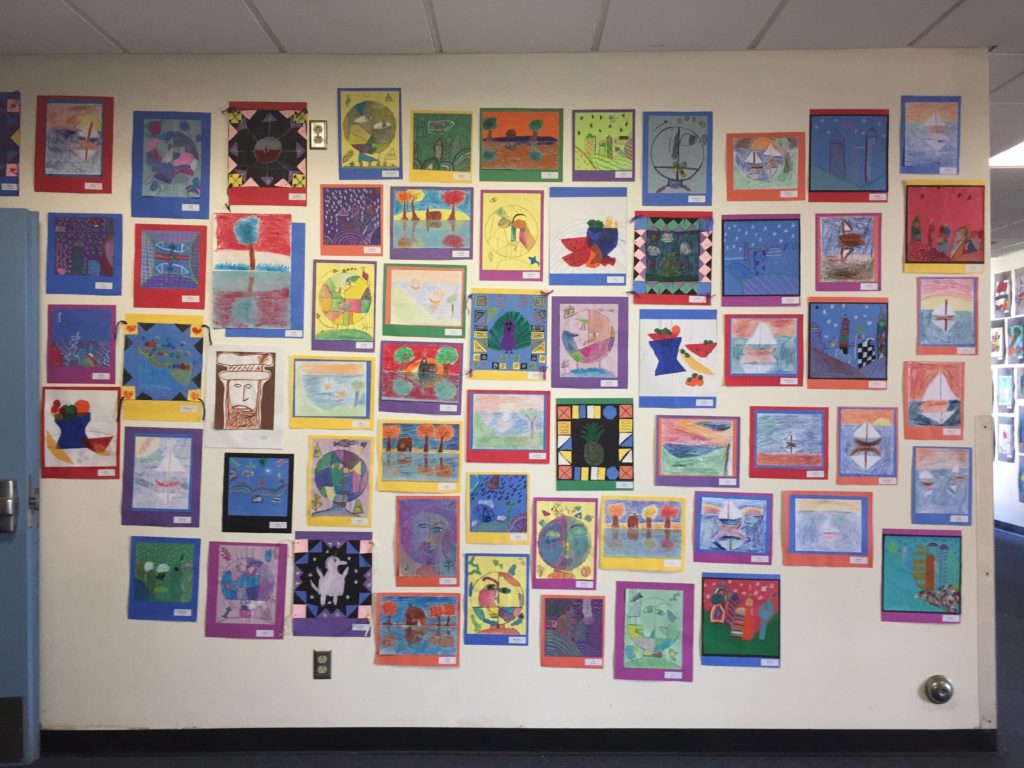Art program lets Mount Vernon students ‘Meet the Masters’
By Kera Wanielista
The Skagit Valley Herald, Washington – March 2018
MOUNT VERNON — At Jefferson Elementary School, a group of second-graders know all about the works of artists such as Vincent van Gogh, Claude Monet and M.C. Escher.
“I like how (van Gogh) has the spheres when he makes his art,” 8-year-old Brad Tormey said. “And I like how he uses different colors all the time.”
As part of the “Meet the Masters” program brought to the school by the Mount Vernon Arts Commission, students were learning Wednesday about the works of Dutch artist Piet Mondrian, whose use of lines, shapes and colors distinguished his art.
“Balance is a very important thing (in Mondrian’s work),” said Cathey Frederick, a retired educator who helped lead the class. “Red is a big, bold color, but it can be balanced by yellow and blue.”
The program has existed since the mid-1980s, according to its website, and has been held after school locally once a week for about two months, said Arts Commission member Andy Schuh.
It seeks to provide adaptable, affordable arts education.
“It’s an opportunity to introduce children to a wide variety of artists, artists’ styles and let them learn to be creative,” Frederick said. “They come back excited each week.”
The Arts Commission paid for the “Meet the Masters” curricula, which includes art supplies so students can re-create the work of famous artists.
“You can see they already have a lot of raw talent, so it’s fun to see them getting the extra exposure,” Schuh said. “It’s a lot of fun to see it happen.”
At Jefferson Elementary, the program is open to second-graders, but each of the lessons can be adjusted to other grade levels, Schuh said.
“It’s an enhancement to the art they already receive in the classroom,” he said. “The hope would be to expand it beyond just an after-school program.”
Amelia Anselment, 7, said she decided to take part in the program because of her grandparents and all the art at their house.
“At their house, it’s very inspiring,” she said.
Gabby Salaz, 8, said she wanted to attend the program because she loves art and learning.
“It’s very cool, because you get to learn and learn and learn and I love, love, love it,” she said.
The idea for the program was brought to the Arts Commission by Mount Vernon Mayor Jill Boudreau, whose children participated in the program when the family was living in California.
“It was so enriching for the kids,” Boudreau said. “They retained the information, they could tell about the artists at 5, 6, 7 years old.”
Boudreau visited the class Wednesday and brought a piece of art one of her children had completed through the “Meet the Masters” program.
The Mount Vernon students, she said, instantly recognized it as being in the style of van Gogh — the swirls gave it away.
“The fun part is watching them recreate,” Boudreau said. “They’re exposed to art as not just a pretty picture, but the person and the process behind being creative.”
The Arts Commission is looking for volunteers to lead classes. Volunteers do not need art or teaching experience. For more information, contact Joni Swanson at the Mount Vernon School District at 360-428-6110.
Village Elementary’s Meet the Masters Art Exhibition – What a Work of Art! (Videos)
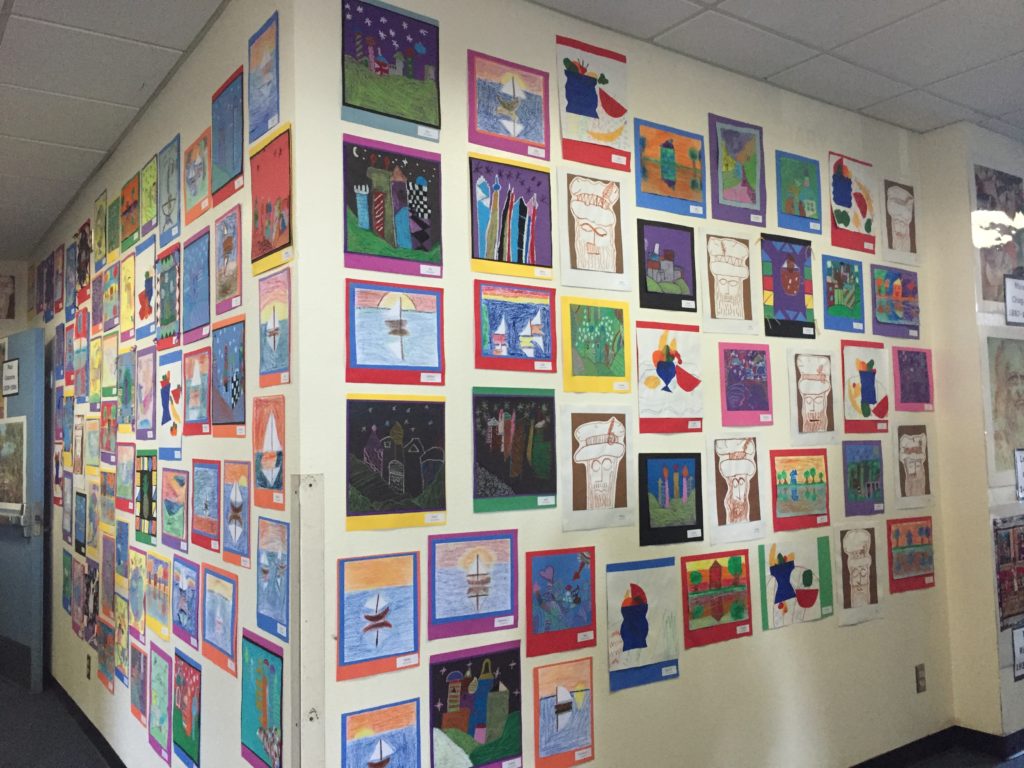 On Thursday, May 11, 2017 Village Elementary hosted its very first “artwalk” to exhibit over 800 masterpieces created this school year by students in grades TK-5 (transitional kindergarten through fifth grade) as they’ve participated in an art program called Meet the Masters. The program, founded by Bonnie Steele, features “historical, culturally diverse, standards-based art lessons to inspire young artists.” With thirty-five masters, including Picasso, Van Gogh, and Kahlo to name a few, students are exposed to the historical background of each artist and then given a chance to emulate each master’s signature style.
On Thursday, May 11, 2017 Village Elementary hosted its very first “artwalk” to exhibit over 800 masterpieces created this school year by students in grades TK-5 (transitional kindergarten through fifth grade) as they’ve participated in an art program called Meet the Masters. The program, founded by Bonnie Steele, features “historical, culturally diverse, standards-based art lessons to inspire young artists.” With thirty-five masters, including Picasso, Van Gogh, and Kahlo to name a few, students are exposed to the historical background of each artist and then given a chance to emulate each master’s signature style.
Videos of “Artwalk” from May 11, 2017
Background: Meet the Masters
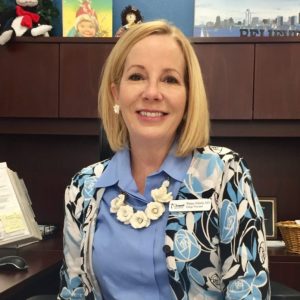
Dr. Whitney DeSantis, the principal of Village Elementary, speaks highly of the art program. “Our Meet the Masters program started a couple of years ago, and, at that time, it was used as an additional resource, as a supplementary art program. We realized the impact that learning about the history of these artists had on our students, and recognized how they were able to make connections to the artists and their work. We noticed that students were so proud of the artwork they were creating. At the same time, teachers were able to integrate writing and reading into the students’ art projects, bringing it all together.”
Dr. DeSantis continues speaking about the program by sharing, “We decided how important the arts are to education and learning. We thought, ‘Let’s see what we can do to make it even more of a school-wide commitment, something that’s on a schedule so every student in every class gets the opportunity to learn art history and create something.’ That’s how Meet the Masters became a school-wide program. With the parents in the Parent Teacher Organization (PTO) wanting their children to be involved in art, they were ready to jump in to help; we just had to figure out how we were going to make it work. The PTO hired Cyndi Fuhrmann as a facilitator for Meet the Masters, and the PTO being able to fund her has been a blessing because otherwise we wouldn’t have the money to fund her. What’s wonderful is that the children are learning about art in the teachers’ classrooms, where it’s full inclusion, and all the students are participating. The teachers are with their students, right in the thick of it, instead of it being a separate pull-out, 45 minutes every-other-week specials program. We wanted it to be more than that.”
As facilitator for Meet the Masters, Cyndi Fuhrmann has had her hands full serving as the liaison between the parent volunteers and teachers, but it’s evident that all the hours she’s put in have been more than worthwhile. She’s not only taken the initiative to organize the supplies by grade level, but she’s also trained parent volunteers, even those who initially possessed very little art history knowledge themselves. Cyndi has walked parent volunteers through the Meet the Masters program, showing them the three steps involved in the program and explaining how to prep the materials for each art lesson. When parent volunteers weren’t available for a Meet the Masters lesson in a particular classroom, Cyndi herself has rolled up her sleeves, happy to be the one to provide art instruction to the eager students. Other times, she has gone into the classrooms where her assistance was requested, working side by side with parent volunteers and/or teachers as they taught a Meet the Masters lesson, which takes place over the course of two days.
Cyndi says, “The best thing about this program is that the students get a significant historical perspective of each artist, getting two lessons about him or her. The first lesson is a slideshow of the different aspects of the master, including examples of his or her work as well as personal details that are interesting. In the second lesson, students use some of the influence of that artist to create whatever they’re going to create, with different mediums each time. As they go up in the grade levels, mediums may repeat, but lessons are differentiated. The way the program is set up, there are beginning, intermediate, and advanced lessons, and the slideshows and art projects are designed to cater to each grade level.”
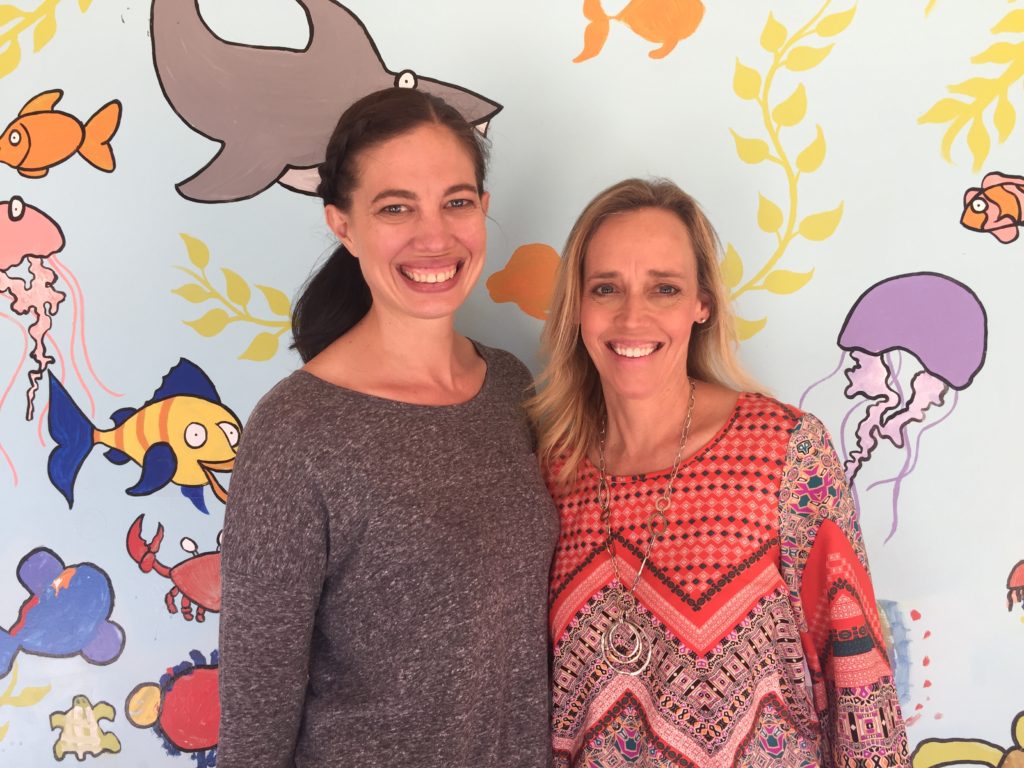
First grade teacher Devon Roberts was one of the first teachers who was lucky enough to have the opportunity to work with Cyndi as Village Elementary was in the process of implementing the Meet the Masters program throughout the school. As a teacher as well as a parent, Ms. Roberts sees firsthand the merits of the Meet the Masters program. She shares a funny story about how her own daughter, who’s in kindergarten, was telling her husband all about “Andy,” as in Andy Warhol. When her husband asked her to elaborate about Warhol, her kindergarten daughter explained that he was known for his realistic art, including painting pictures of soup cans. “My five year old is coming home talking about Andy Warhol,” Ms. Roberts laughs.
Ms. Roberts says, “I have a different perspective being a parent and a teacher. I’ve seen it [Meet the Masters] come home when my daughter talks about it, and it’s so nice because, as a teacher, you don’t always know how much of a student’s day makes it to the dinner table. My daughter talks about Gaugin, and she’s even corrected my pronunciation of his name, which tells me that what she’s learning is sticking, even in kindergarten!”
She continues, “It’s been nice studying each artist, and having students compare each artist’s style with previous masters they’ve studied. This year we’ve studied one artist per month, and the kids really look forward to it. They love having their parents come in to volunteer. They look forward to our two-day art lessons, and know that there’s going to be a slide show where they learn about a particular artist, followed by creating an art project themselves.”

“I love it as a teacher because it’s a program that’s ready. The parents are trained, and they organize everything, so it’s really a time when I can sit back and watch the process,” Ms. Roberts says. She shares that one of the aspects of the program that she particularly enjoys is that she herself, thanks to the parent volunteers, gets to take the time to watch the kids enjoy art, and because she’s not the one leading the instruction, she can really focus on absorbing how much art means to the kids, observing how thoroughly engaged her class is as they try to become masters themselves.
Although students may think their teachers know everything, Ms. Roberts herself learns something new with each art lesson. “After traveling to Europe to study art history, I thought I knew a lot about art, but it turns out I did not know as much as I thought I knew,” Ms. Roberts confesses. Of the artists she herself has learned about through this program she shares, “I’ve learned a lot about their lives, their quirks, and interesting facts about them I would otherwise never have known. I always find it exciting when I learn new things in the process, but I find it even more exciting to know that my students are retaining it. Even a week or two after learning about an artist, they will make a connection in our guided reading group with one of them saying, ‘Ms. Roberts, this picture looks like a Picasso or a Monet.’ The fact that six and seven year olds have that information is astonishing, and I think it was definitely part of our curriculum that was lacking before. That hole has been filled with Meet the Masters.”
“It’s so amazing that the PTO has done this for us, and that the parents do all the prep work to make it possible. It’s nice knowing that students will have this program TK-5 and that they’ll be exposed to art history throughout elementary school. I never had that,” Ms. Roberts reflects. “I think developing more well-rounded children is something that we can always get better at, and I think this program is definitely a step in the right direction. You never know which kid’s passion could have been art, but it was never tapped. We never know what kids will choose to do when they’re older, so I think this program is important because it taps into kids’ potential,” she says.
 One of the aspects that Ms. Roberts also appreciates about the Meet the Masters program is that students are given the opportunity to work with a number of mediums, including paint, sandpaper, oil pastels, and tempura paint. The program, according to Ms. Roberts, allows students “to get away from just working with crayons and watercolors.” She likes how the students learn about different colors (primary, warm, and cool) and how they now understand the significance of choosing one over the other. She shares, “The feedback I’ve gotten from parents has been amazing!”
One of the aspects that Ms. Roberts also appreciates about the Meet the Masters program is that students are given the opportunity to work with a number of mediums, including paint, sandpaper, oil pastels, and tempura paint. The program, according to Ms. Roberts, allows students “to get away from just working with crayons and watercolors.” She likes how the students learn about different colors (primary, warm, and cool) and how they now understand the significance of choosing one over the other. She shares, “The feedback I’ve gotten from parents has been amazing!”
Another important takeaway from the program is that art isn’t perfect. Students learn about the struggles that some artists, who are now considered masters, faced in their own lifetimes, how people laughed at their work and refused to buy it. Some of the masters weren’t even accepted as legitimate artists while they were alive, and as students learn about the artists’ personal lives, they begin to realize that no one’s opinion matters other than the artist’s. Van Gogh, who only sold one painting during his lifetime, painted more than nine hundred works. Students, who are sometimes critical of their own work, not only learn about the artists’ styles, but learn from the artists the value of perseverance and believing in oneself. “For a lot of my kids who need to be perfect, this program has helped them understand that as long as you try, it’s okay if it’s not perfect. That’s carried over into other things. For a lot of kids, that’s a really hard lesson, and I think this program does a great job with that,” Ms. Roberts says.
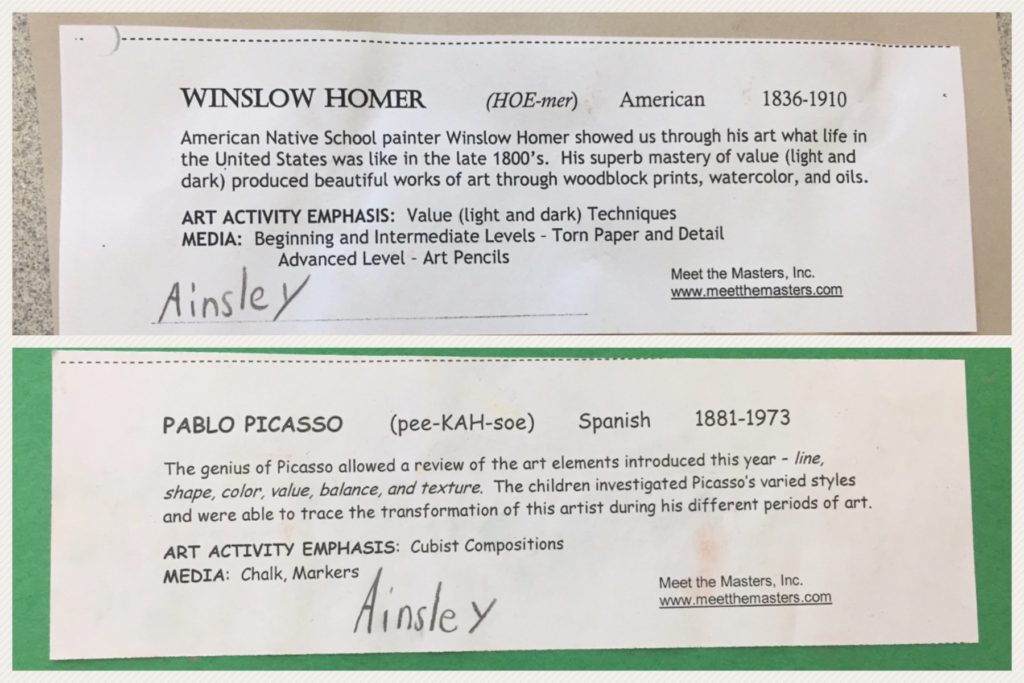
Cyndi remarks, “This program teaches each student that you’re allowed to have your own opinion, and you, in turn, need to respect other people’s opinions. You can like abstract art, but if someone else doesn’t appreciate it, that’s okay. Picasso did cubism, but if you prefer realism, that’s allowed. You’re allowed to like what you like, and there’s no right or wrong when it comes to art.” Cyndi equates learning new art styles to trying new foods. How are you ever going to know if you like something without trying it? Meet the Masters allows students to learn about new art styles, and then try it themselves. Even if it’s not their favorite style, it’s okay because they’ve at least tried it.
The Artwalk on May 11, 2017
For those parents who may be wondering why they haven’t seen any of their children’s Meet the Masters artwork come home yet this year, Cyndi explains that the parent volunteers have been collecting the kids’ masterpieces in portfolios all school year. Cyndi says, “We saved the artwork throughout the year instead of sending it all home specifically so we could have this artwalk.” (Portfolios will be sent home at the end of the school year.)
She explains, “We felt the kids needed to reflect on their pieces. Each student got to look through his or her portfolio and decide which piece of art he or she wanted displayed in the artwalk.” Cyndi reflects, “If we had sent all the art pieces home one at a time, kids may have thought, ‘This must be the best piece because it’s the one Mom hung on the wall.’ Instead, we wanted the kids to be the ones to decide for themselves which pieces were the ones that made them feel the most proud, to take ownership of their own artistic work.” Ms. Roberts shares, “In my class, they all knew which pieces they wanted displayed for the artwalk, and they remembered pieces that they made even back in September.”
 The inaugural artwalk was not a fundraiser, but rather a celebration. Cyndi wanted all the budding artists to take pride as they saw their work on display, and wanted to honor the forty plus volunteers who helped make the Meet the Masters program such a huge success this school year. Cyndi speaks so highly of all the volunteers, whether they volunteered once or on a regular basis, saying, “This program has created a community spirit among the parents. It’s a special feeling to have a group united with the same goal of helping all the kids. My hope is that the continued parental support is what will make this program sustainable at Village Elementary.” Ms. Roberts adds, “It’s the perfect instrument for parents who want to volunteer, and teachers are beyond thankful to all the parents who make learning about art such a wonderful experience for our students.”
The inaugural artwalk was not a fundraiser, but rather a celebration. Cyndi wanted all the budding artists to take pride as they saw their work on display, and wanted to honor the forty plus volunteers who helped make the Meet the Masters program such a huge success this school year. Cyndi speaks so highly of all the volunteers, whether they volunteered once or on a regular basis, saying, “This program has created a community spirit among the parents. It’s a special feeling to have a group united with the same goal of helping all the kids. My hope is that the continued parental support is what will make this program sustainable at Village Elementary.” Ms. Roberts adds, “It’s the perfect instrument for parents who want to volunteer, and teachers are beyond thankful to all the parents who make learning about art such a wonderful experience for our students.”
As excited children entered the artwalk, with moms, dads, and even grandparents in tow, they eagerly searched for their own masterpieces, arranged by grade order from TK-5. Each student’s artwork was presented in true gallery fashion, with his or her first name, grade level, and teacher listed on the artwork’s mounting. Parents took pictures of their children as they posed next to their artwork, and it was fun watching kids not only take pride in their own art, but also pointing out their classmates’ pieces with admiration.
Samples of some of the Meet the Masters artists’ work that students studied this year were hung alongside the students’ art, and at the start of each grade level, a sign was posted (on an easel, of course) that indicated the names of the artists studied by that grade level.
As people weaved their way through the artwalk, it was evident how impressed they were with the quality of artwork produced by the elementary students. Long gone are the days of stick figures and arts and crafts – this was a serious display of high quality pieces, any of which could easily be framed (and most likely will be framed once portfolios head home).
Parents Chris and Sally Harvey, whose two sons attend Village Elementary, were thrilled with the artwalk. “I think this is a phenomenal representation of what the kids have learned. I love that it incorporates history as well as creative expression,” Sally commented. Chris shared, “I think this is the type of thing that pushes kids in the right direction, giving them a challenge, but also giving them perspective of what art should be.”
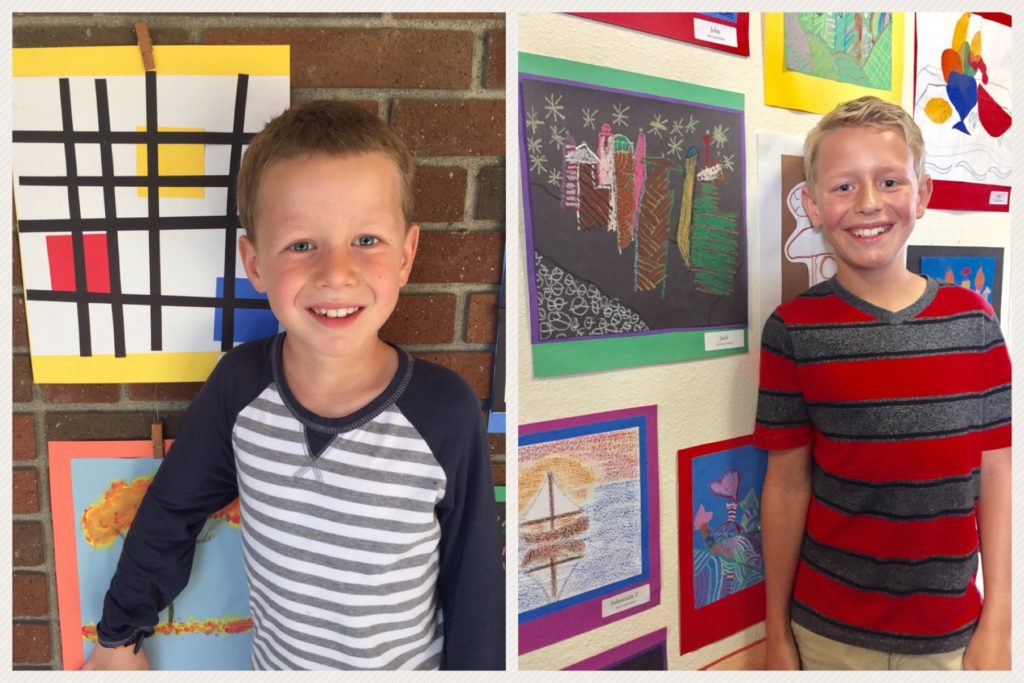
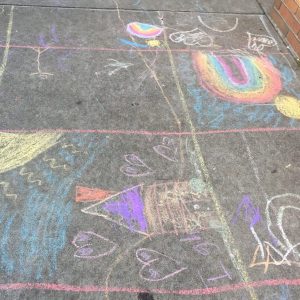
Of course, no celebration could be complete without pizza, and the PTO was there to graciously host dinner, free of charge. (They even threw in some carrots to ensure kids ate their vegetables.) After going through fifty-one large pizzas, there was no doubt that there was a substantial turnout for the inaugural artwalk. While parents enjoyed a night where no one had to cook, children played with their friends. Inspired by all the beautiful artwork they had just witnessed as they strolled though the artwalk, the budding young artists felt compelled to keep creating more art, brightly decorating the sidewalk with festive images crafted with chalk.

Toni Brickhaus, who’s volunteered all year long with the Meet the Masters program, was on hand to help pass out pizza. As she looked around the courtyard of smiling faces surrounding her, she summarized, “I think the Meet the Masters program is awesome! I went into the first lesson really nervous, thinking I could not do it, but it is so step-by-step that, by the end, I felt like I was a super pro. Before long, I was even being asked to help in other classrooms!”
She continued, “I just think it’s a great way to bring art into our schools. The kids were always so excited whenever I walked in, immediately asking, ‘Are you here to do Meet the Masters with us?’ If I wasn’t they would all look so disappointed, which really emphasized to me how much they love this program. I personally have learned so much by teaching Meet the Masters, including different artists’ styles and that white is not a color, but rather a tint. I’ve learned to appreciate details that earlier I never would have been able to pick out in the masters’ artwork that we’ve studied. This year I’ve been exposed to a lot of artwork that I was unfamiliar with, and I’ve also seen other artwork that I recognized, but knew nothing about the artists who created them. It was interesting to me to start making those connections, and made me appreciate the masters’ works even more.”
 Upon hearing about Village Elementary’s art exhibition, Meet the Masters Founder, Bonnie Steele shared, “I am very excited to learn that Village Elementary is proudly displaying their young artists’ masterpieces! Art students of all ages simply ‘beam’ when seeing their artwork being shared and admired by others. It stimulates their creativity and excitement for future endeavors, and reinforces that art is important and valued in our culture. Thanks also to the funding partners who also see the value in providing quality art education in the elementary grades.”
Upon hearing about Village Elementary’s art exhibition, Meet the Masters Founder, Bonnie Steele shared, “I am very excited to learn that Village Elementary is proudly displaying their young artists’ masterpieces! Art students of all ages simply ‘beam’ when seeing their artwork being shared and admired by others. It stimulates their creativity and excitement for future endeavors, and reinforces that art is important and valued in our culture. Thanks also to the funding partners who also see the value in providing quality art education in the elementary grades.”
The first artwalk was definitely a success, and it’s apparent that the combination of Meet the Masters, students with an enthusiastic willingness to learn about art, and a steady stream of parent volunteers have created a masterpiece of their own at Village Elementary!
Related Video:
(A powerful video about the importance of harnessing the creativity in children)
Rancho Elementary students meet Pablo Picasso
Thanks to an art program called Meet The Masters, put on largely by volunteers with support from the school and grant funding, students at Rancho Elementary are learning about famous artists and putting their art techniques into practice.
The Orange County-based Meet The Masters has introduced students to famed artists —- from painters to potters hailing from several counties —- such as Claude Monet, Vincent Van Gogh, Maria Martinez, Piet Mondrian, Henri Matisse, Leonardo da Vinci, Gustav Klimt and Pablo Picasso.
At Rancho Elementary, volunteer Elizabeth Harrigan, the mother of twin fifth-grade boys at the school, has led the program for the last two years, offering art instruction with the help of other parent volunteers.
The art lessons, held in the school’s art room and offered to students in all the grades, follow an hourlong assembly hosted by a Meet The Masters staffer who uses a slideshow and art samples to teach the students about the artist and his or her techniques. The program at Rancho is a mixture of art appreciation and application.
In the week that follows the assembly, Harrigan and the other trained volunteers, with help from the classroom teachers, bring out the art supplies and the students get to work. The students have used a range of mediums including oils, chalks, pastels, pens and clay, as well as printmaking. Their school’s program includes the introduction of five different artists each year.
Last week, students attended an assembly about Picasso and learned about his different periods of works and his unique abstract and avant-garde style called Cubism. In the art room, students are creating Picasso-like drawings using pens and chalk, an art medium most students said they haven’t used before.

“I don’t want to see two shapes touching each other in the same color,” Harrigan instructed the fifth-graders in David Cook’s class as they worked to color in an outline of a Picasso drawing Wednesday, following Tuesday’s Picasso assembly.
Student Lorenzo Mills said using the chalks was a challenge. Students were instructed to create piles of chalk dust and then dab cotton balls into the dust to fill the color into the blocks on the Picasso design outlines.
“They’re all over the place,” Lorenzo said of the chalk powders.
Kayla Young was one of the many students who said they were enjoying the art project despite the messy chalks. “We get to express ourselves,” she said.
Added student Steven Solis, “We get to do art and it takes away stress.”
Harrigan said she knows for a fact that the lessons stick long after the students learn about a particular artist.
“Parents tell me all the time, ‘It’s amazing my kids recognize this art when they see it in places.’”
“This also gives them a chance to touch professional-quality art supplies, too, and just get a taste of what’s out there at a young age,” she said.
Harrigan said she offered to lead the Meet The Masters Program at Rancho when she saw how much her two sons, Henry and Matthew, liked it. She also has a background in art, having been a hobby artist most of her life and working professionally for 10 years as an art director for a footwear company.
“She is a phenomenal volunteer,” Rancho Elementary Principal Pam May said of Harrigan.
Source: San Diego Union Tribune

